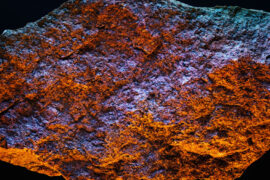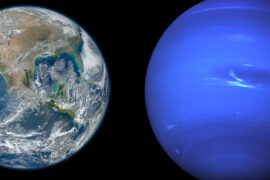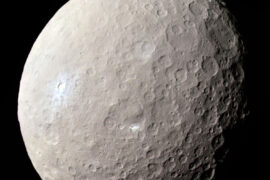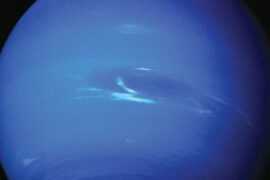Triton is one of the most intriguing objects in the Solar system. Since its discovery in 1864, it was obvious that there was something very interesting about it. It was (and still is) the only moon in the solar system that has a retrograde orbit, which means it orbits in the opposite direction of the planet’s rotation. At the time astronomers didn’t even know that was possible. It was very curious.
For more than a century we didn’t know much about Triton. Because it is so far away from the Sun, we assumed it was mostly inactive and uninteresting. This changed in 1989 when the Voyager 2 space probe flew by on its way out of the Solar system.
Astronomers realized Triton was very much alive. As it turns out, there’s geological activity, an atmosphere that is going through a change period, an intense ionosphere, and maybe even liquid water?
This is why in recent decades, some astronomers have tried to push projects for NASA to send a probe to study Neptune and Triton. And even though there’s a long list of interesting moons that need to be studied further like Europa and Io, the idea of sending a probe to Triton has started to gain traction.
Triton by the numbers
| Value | Compared to Earth | |
|---|---|---|
| Name | Triton | |
| Designation (scientific name) | Neptune I | |
| Date of discovery | October 10, 1846 | |
| Discovered by | William Lassell | |
| Radius | 1,353 km (840.7 miles) | 0.2122 |
| Mass | 2.14 ×1022 kg | 0.00359 |
| Density (mean) | 2.061 g/cm | |
| Gravity | 0.779 m/s2 | 0.0794 g |
| Temperature | 38 K (−235.2 °C) | |
| Surface pressure | 1.4 to 1.9 Pa | |
| Orbital period | 5.88 days | |
| Orbital speed | 4.39 km/s | |
| Rotation period | tidally locked | |
| Apparent magnitude | 13.47 | |
| Absolute magnitude | -1.2 | |
| Atmospheric composition | Nitrogen, methane. |
Triton key characteristics

- Triton has a retrograde orbit. That is, Triton rotates in the opposite direction as its planet’s rotation. It is the only large moon in the Solar system that does this. The only other satellites with similar orbits are some of the smaller, distant, and irregular moons of Jupiter and Saturn.
- Triton is larger than some dwarf planets. It is bigger than Pluto and Eris, but it is about 20% smaller than our Moon.
- Triton has ice volcanoes. These are called cryovolcanoes and they are made out of frozen nitrogen and other types of ice. Their eruptions let out ammonia, methane, and maybe even ice water.
- Triton has a dark side. Just like our Moon, Triton is tidally locked to its planet, which means its rotation is synced to the orbital plane of Neptune. This means that if you could stand on Neptune, you would only see one side of Titon aat all times and you couldn’t see the “dark side” of the moon.
- Triton has an atmosphere. Unlike most moons, Triton has a relatively dense atmosphere that might be partially responsible for its volcanic activity. While it is thin compared to a planet’s atmosphere, it is thick when compared to other moons. It is possible this atmosphere made out of Nitrogen and methane could be causing a greenhouse effect that heats up the moon enough so that the elements below the crust have to find a way out through eruptions.
- Triton has a frozen crust. Triton might be like a giant ice lake. It has a solid crust of ice at the very top that covers the inner layers of the planet. This crust is made out mostly of nitrogen ice, but some other types of ice are blended together, including possible ice water. And speaking of the inner layers of Triton…
- Triton might have liquid water below its crust. While it is not confirmed. It is possible that the layer below Triton’s crust is a giant ocean of liquid that could cover the whole moon. This could happen because radiation decay creates enough heat to keep a subsurface of water in liquid form. This is one of the things that gets scientists most excited about studying and learning more about moons such as Triton, Europa, or Enceladus.
5 Triton interesting facts
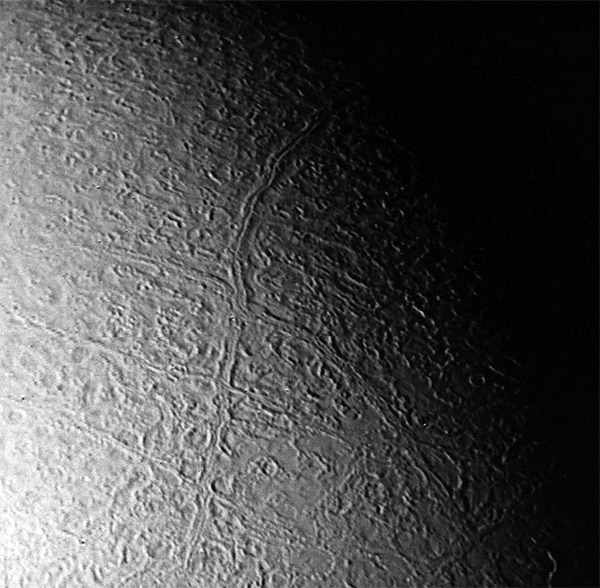
1) Triton is heating up
The most recent measurements of Triton’s atmosphere show that the moon is undergoing a transformation. Its atmosphere has become denser since the Voyager 2 took the first observations in 1989.
Due to this, it is very likely that Triton’s temperature is also going up because of the greenhouse effect. It is possible this could be caused by all the geological activity (ice volcanoes) that is happening on its crust.
2) Triton could be an ocean world
Astronomers believe that under Triton’s icy shell lies a whole ocean that could cover the entirety of the moon’s surface.
At first, it was believed this ocean would be made out of liquid nitrogen, like the atmosphere. But recent theories suggest that it could actually be water.
The reason why Triton could support an ocean of liquid water is because of the composition of its core. The metals and silicate materials there are theorized to be generating enough radiation decay to heat up this layer of the planet, creating the necessary temperatures to support liquid water.
3) It has a very low number of craters
When you look at the face of most large moons, you can see lots of scars left by meteorite and asteroid impacts. These craters tell a lot about the history of these satellites.
But when you look at Triton, it doesn’t have many. Why?
Well, this isn’t because Triton has been fortunate to not see many impacts. It has had as many as all the other moons. It is just good at covering up its own craters. like makeup but for moons.
This effect happens because of Triton’s volcanoes and geological activity. As “ice lava” and other materials are constantly ejected into the surface, they cover up the craters. This happens in all other bodies that are very active geologically, like Earth.
4) Triton will “soon” crash with Neptune
Triton’s orbit is slowly depressing, and one day, this satellite will lose enough energy and will completely “descend” onto Neptune, crashing with the planet.
This is because of friction caused by the tidal action between their two masses.
In astronomical terms, this is expected to happen “soon”. It is estimated the descent will begin in about 10 million years.
5) Triton looks like a cantaloupe
One unique feature of Triton that isn’t found in any other body in the solar system is that about half of its surface has some very peculiar fissures that when you look at them from afar, look very much like the outer skin of a cantaloupe.
This “texture” covers much of the western side of the moon and it is believed to be made up of diapirs, a type of geological “canals” that form in areas with low tectonic stress. On Earth, these occasionally happen but only in certain regions and are not too common.
Bonus) Triton could support life
Let me preface this by saying that this is a big IF. In fact, it is a large series of ifs.
If Triton really does have an ocean under its icy surface, if it is actually made out of water, and if the conditions of the moon’s core maintain the necessary conditions, then it could be (remotely) possible for Triton to be able to support some form of life.
This theory has gained a little more traction because some observations have captured some dark materials being ejected by some of its volcanoes. It is believed that these might contain organic compounds.
Currently, there are no set plans to send a probe to explore Neptune and Triton. It is unlikely such a mission could happen before 2040 as all the efforts of the various space agencies around the world are being directed at other planets.
Common questions about Triton answered.
Why does Triton have a retrograde (backwards) orbit?
Neptune, like most of the planets in the Solar system (except Venus and Uranus) rotates counterclockwise. Triton orbits clockwise. This is rare because generally the moons of a planet orbit in the same direction as the planet’s rotation.
The most likely theory as to why Triton has a retrograde orbit is that it originally was a dwarf planet that originated in the Kuiper belt like Pluto. A collision with another object could have slowed down and modified Triton’s orbit enough for it to be captured by Neptune’s gravity.
Triton’s capture could have resulted in it colliding with other of Neptune’s moons. It is possible it could have ejected at least one or modified the orbits of the others.
Where does Triton get its name from?
Triton was named after the Greek god of the same name who was the son of Poseidon in Greek mythology. Poseidon is the god of the seas in Greek mythology and is the equivalent to the Roman deity Neptune. In some way, you could say that Triton is Neptune’s son which makes the name very fitting.
Triton distance from Neptune
Triton is located 354,760 kilometers (220,438 miles) away from Neptune. That is very similar to the Moon’s distance from Earth which is 384,400 km (less than 10% more).
Triton’s age and formation
Like most of the rest of the Solar system, Triton was formed approximately 4.5 billion years ago out of a cloud of gas and dust that started to fuse together thanks to gravitational forces.
It is believed that Triton originated in the Kuiper belt, an area on the outer edges of the Solar system where remnants of ice, dust, and rock that were leftover from the formation of the planets created asteroid comets, and maybe a couple of dwarf planets like Pluto.
Triton then would have collided with another object that took it out of its course enough so it could be captured by Neptune’s gravity. This would explain why Triton, Pluto, and Charon have similar compositions.


